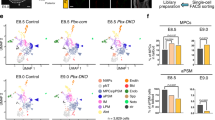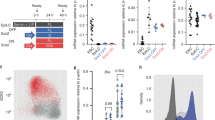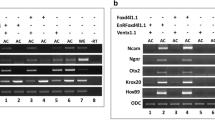Abstract
The classical view of neural plate development held that it arises from the ectoderm, after its separation from the mesodermal and endodermal lineages. However, recent cell-lineage-tracing experiments indicate that the caudal neural plate and paraxial mesoderm are generated from common bipotential axial stem cells originating from the caudal lateral epiblast1,2. Tbx6 null mutant mouse embryos which produce ectopic neural tubes at the expense of paraxial mesoderm3 must provide a clue to the regulatory mechanism underlying this neural versus mesodermal fate choice. Here we demonstrate that Tbx6-dependent regulation of Sox2 determines the fate of axial stem cells. In wild-type embryos, enhancer N1 of the neural primordial gene Sox2 is activated in the caudal lateral epiblast, and the cells staying in the superficial layer sustain N1 activity and activate Sox2 expression in the neural plate4,5,6. In contrast, the cells destined to become mesoderm activate Tbx6 and turn off enhancer N1 before migrating into the paraxial mesoderm compartment. In Tbx6 mutant embryos, however, enhancer N1 activity persists in the paraxial mesoderm compartment, eliciting ectopic Sox2 activation and transforming the paraxial mesoderm into neural tubes. An enhancer-N1-specific deletion mutation introduced into Tbx6 mutant embryos prevented this Sox2 activation in the mesodermal compartment and subsequent development of ectopic neural tubes, indicating that Tbx6 regulates Sox2 via enhancer N1. Tbx6-dependent repression of Wnt3a in the paraxial mesodermal compartment is implicated in this regulatory process. Paraxial mesoderm-specific misexpression of a Sox2 transgene in wild-type embryos resulted in ectopic neural tube development. Thus, Tbx6 represses Sox2 by inactivating enhancer N1 to inhibit neural development, and this is an essential step for the specification of paraxial mesoderm from the axial stem cells.
This is a preview of subscription content, access via your institution
Access options
Subscribe to this journal
Receive 51 print issues and online access
$199.00 per year
only $3.90 per issue
Buy this article
- Purchase on Springer Link
- Instant access to full article PDF
Prices may be subject to local taxes which are calculated during checkout




Similar content being viewed by others
References
Diez del Corral, R. & Storey, K. Opposing FGF and retinoid pathways: a signalling switch that controls differentiation and patterning onset in the extending vertebrate body axis. Bioessays 26, 857–869 (2004)
Wilson, V., Olivera-Martinez, I. & Storey, K. Stem cells, signals and vertebrate body axis extension. Development 136, 1591–1604 (2009)
Chapman, D. & Papaioannou, V. Three neural tubes in mouse embryos with mutations in the T-box gene Tbx6 . Nature 391, 695–697 (1998)
Takemoto, T., Uchikawa, M., Kamachi, Y. & Kondoh, H. Convergence of Wnt and FGF signals in the genesis of posterior neural plate through activation of the Sox2 enhancer N-1. Development 133, 297–306 (2006)
Uchikawa, M., Ishida, Y., Takemoto, T., Kamachi, Y. & Kondoh, H. Functional analysis of chicken Sox2 enhancers highlights an array of diverse regulatory elements that are conserved in mammals. Dev. Cell 4, 509–519 (2003)
Kamachi, Y. et al. Evolution of non-coding regulatory sequences involved in the developmental process: reflection of differential employment of paralogous genes as highlighted by Sox2 and group B1 Sox genes. Proc. Jpn. Acad. Ser. B 85, 55–68 (2009)
Selleck, M. & Stern, C. Fate mapping and cell lineage analysis of Hensen’s node in the chick embryo. Development 112, 615–626 (1991)
Tzouanacou, E., Wegener, A., Wymeersch, F., Wilson, V. & Nicolas, J. Redefining the progression of lineage segregations during mammalian embryogenesis by clonal analysis. Dev. Cell 17, 365–376 (2009)
Brown, J. & Storey, K. A region of the vertebrate neural plate in which neighbouring cells can adopt neural or epidermal fates. Curr. Biol. 10, 869–872 (2000)
Cambray, N. & Wilson, V. Two distinct sources for a population of maturing axial progenitors. Development 134, 2829–2840 (2007)
Mathis, L., Kulesa, P. & Fraser, S. FGF receptor signalling is required to maintain neural progenitors during Hensen’s node progression. Nature Cell Biol. 3, 559–566 (2001)
Delfino-Machín, M., Lunn, J., Breitkreuz, D., Akai, J. & Storey, K. Specification and maintenance of the spinal cord stem zone. Development 132, 4273–4283 (2005)
Chapman, D., Agulnik, I., Hancock, S., Silver, L. & Papaioannou, V. Tbx6, a mouse T-Box gene implicated in paraxial mesoderm formation at gastrulation. Dev. Biol. 180, 534–542 (1996)
Yasuhiko, Y. et al. Functional importance of evolutionally conserved Tbx6 binding sites in the presomitic mesoderm-specific enhancer of Mesp2 . Development 135, 3511–3519 (2008)
Yasuhiko, Y. et al. Tbx6-mediated Notch signaling controls somite-specific Mesp2 expression. Proc. Natl Acad. Sci. USA 103, 3651–3656 (2006)
Hofmann, M. et al. WNT signaling, in synergy with T/TBX6, controls Notch signaling by regulating Dll1 expression in the presomitic mesoderm of mouse embryos. Genes Dev. 18, 2712–2717 (2004)
White, P. & Chapman, D. Dll1 is a downstream target of Tbx6 in the paraxial mesoderm. Genesis 42, 193–202 (2005)
Beckers, J. et al. Distinct regulatory elements direct delta1 expression in the nervous system and paraxial mesoderm of transgenic mice. Mech. Dev. 95, 23–34 (2000)
Bouillet, P. et al. A new mouse member of the Wnt gene family, mWnt-8, is expressed during early embryogenesis and is ectopically induced by retinoic acid. Mech. Dev. 58, 141–152 (1996)
Yamaguchi, T. Genetics of Wnt signaling during early mammalian development. Methods Mol. Biol. 468, 287–305 (2008)
Sun, X., Meyers, E., Lewandoski, M. & Martin, G. Targeted disruption of Fgf8 causes failure of cell migration in the gastrulating mouse embryo. Genes Dev. 13, 1834–1846 (1999)
Takada, S. et al. Wnt-3a regulates somite and tailbud formation in the mouse embryo. Genes Dev. 8, 174–189 (1994)
Trichas, G., Begbie, J. & Srinivas, S. Use of the viral 2A peptide for bicistronic expression in transgenic mice. BMC Biol. 6, 40 (2008)
Tonegawa, A. & Takahashi, Y. Somitogenesis controlled by Noggin. Dev. Biol. 202, 172–182 (1998)
Dosch, R., Gawantka, V., Delius, H., Blumenstock, C. & Niehrs, C. Bmp-4 acts as a morphogen in dorsoventral mesoderm patterning in Xenopus . Development 124, 2325–2334 (1997)
Wilkinson, D. G. In situ hybridization: a practical approach (IRL at Oxford Univ. Press, 1992)
Xu, P. et al. Regulation of Pax6 expression is conserved between mice and flies. Development 126, 383–395 (1999)
Mansouri, A. et al. Paired-related murine homeobox gene expressed in the developing sclerotome, kidney, and nervous system. Dev. Dyn. 210, 53–65 (1997)
Sawada, A. et al. Redundant roles of Tead1 and Tead2 in notochord development and the regulation of cell proliferation and survival. Mol. Cell. Biol. 28, 3177–3189 (2008)
Dressler, G., Deutsch, U., Chowdhury, K., Nornes, H. & Gruss, P. Pax2, a new murine paired-box-containing gene and its expression in the developing excretory system. Development 109, 787–795 (1990)
Sasaki, H. & Hogan, B. Differential expression of multiple fork head related genes during gastrulation and axial pattern formation in the mouse embryo. Development 118, 47–59 (1993)
Kimura-Yoshida, C. et al. Canonical Wnt signaling and its antagonist regulate anterior-posterior axis polarization by guiding cell migration in mouse visceral endoderm. Dev. Cell 9, 639–650 (2005)
Crossley, P. & Martin, G. The mouse Fgf8 gene encodes a family of polypeptides and is expressed in regions that direct outgrowth and patterning in the developing embryo. Development 121, 439–451 (1995)
Niswander, L. & Martin, G. Fgf-4 expression during gastrulation, myogenesis, limb and tooth development in the mouse. Development 114, 755–768 (1992)
Roelink, H. & Nusse, R. Expression of two members of the Wnt family during mouse development—restricted temporal and spatial patterns in the developing neural tube. Genes Dev. 5, 381–388 (1991)
Nagy, A., Gertsenstein, M., Vinterten, K. & Behringer, R. Manipulating the Mouse Embryo: a Laboratory Manual 3rd edn (Cold Spring Harbor Laboratory Press, 2003)
Yamamoto, M. et al. Nodal antagonists regulate formation of the anteroposterior axis of the mouse embryo. Nature 428, 387–392 (2004)
Katoh, K., Takahashi, Y., Hayashi, S. & Kondoh, H. Improved mammalian vectors for high expression of G418 resistance. Cell Struct. Funct. 12, 575–580 (1987)
Yagi, T. et al. A novel negative selection for homologous recombinants using diphtheria toxin A fragment gene. Anal. Biochem. 214, 77–86 (1993)
Sakai, K. & Miyazaki, J. A transgenic mouse line that retains Cre recombinase activity in mature oocytes irrespective of the cre transgene transmission. Biochem. Biophys. Res. Commun. 237, 318–324 (1997)
Kamachi, Y. & Kondoh, H. Overlapping positive and negative regulatory elements determine lens-specific activity of the delta 1-crystallin enhancer. Mol. Cell. Biol. 13, 5206–5215 (1993)
Kispert, A. & Hermann, B. The Brachyury gene encodes a novel DNA binding protein. EMBO J. 12, 4898–4899 (1993)
Conlon, F., Fairclough, L., Price, B., Casey, E. & Smith, J. Determinants of T box protein specificity. Development 128, 3749–3758 (2001)
Acknowledgements
We thank the members of Kondoh laboratory for discussions. This study was supported by Grants-in-Aid for Scientific Research from MEXT Japan to T.T. and H.K., an NIH grant to V.E.P., and MRC funding to R.L.-B.
Author information
Authors and Affiliations
Contributions
T.T. and H.K. conceived the project; T.T. carried out major experiments; T.T. and H.K. analysed data; M.U. and M.Y. aided production and analysis of enhancer N1 mutant mice; V.E.P. provided Tbx6 mutant mice; D.M.B., R.L.-B. and V.E.P. first indicated Sox2 disregulation in the Tbx6 mutant mice; and T.T. and H.K. wrote the manuscript.
Corresponding author
Ethics declarations
Competing interests
The authors declare no competing financial interests.
Supplementary information
Supplementary Figures
The file contains Supplementary Figures 1-7 with legends. (PDF 23976 kb)
Rights and permissions
About this article
Cite this article
Takemoto, T., Uchikawa, M., Yoshida, M. et al. Tbx6-dependent Sox2 regulation determines neural or mesodermal fate in axial stem cells. Nature 470, 394–398 (2011). https://doi.org/10.1038/nature09729
Received:
Accepted:
Published:
Issue Date:
DOI: https://doi.org/10.1038/nature09729
This article is cited by
-
Ascidian embryonic cells with properties of neural-crest cells and neuromesodermal progenitors of vertebrates
Nature Ecology & Evolution (2024)
-
Toll-like receptors 2 and 4 differentially regulate the self-renewal and differentiation of spinal cord neural precursor cells
Stem Cell Research & Therapy (2022)
-
Nr6a1 controls Hox expression dynamics and is a master regulator of vertebrate trunk development
Nature Communications (2022)
-
Ubiquitination of NF-κB p65 by FBXW2 suppresses breast cancer stemness, tumorigenesis, and paclitaxel resistance
Cell Death & Differentiation (2022)
-
An ancestral Wnt–Brachyury feedback loop in axial patterning and recruitment of mesoderm-determining target genes
Nature Ecology & Evolution (2022)
Comments
By submitting a comment you agree to abide by our Terms and Community Guidelines. If you find something abusive or that does not comply with our terms or guidelines please flag it as inappropriate.



